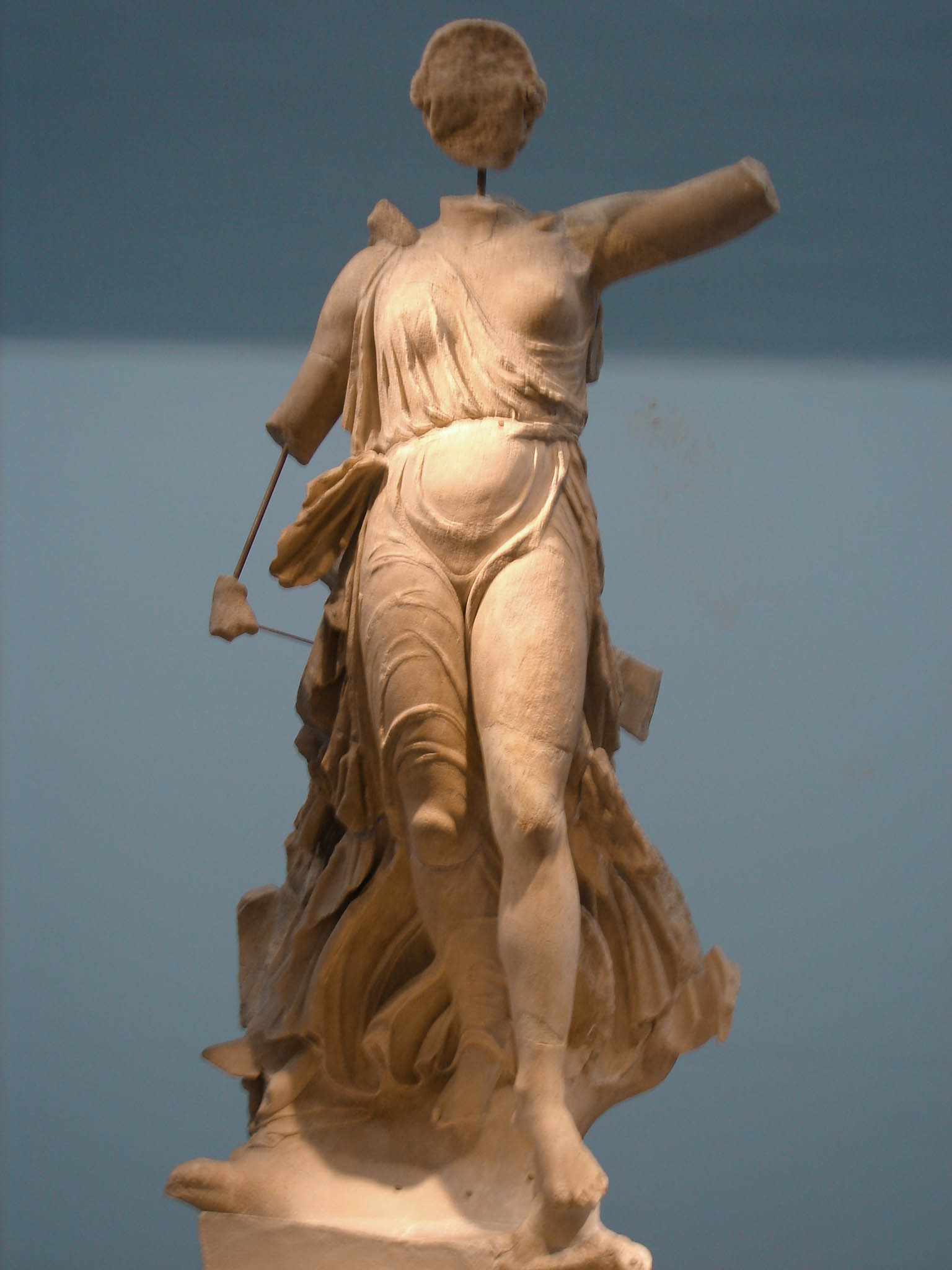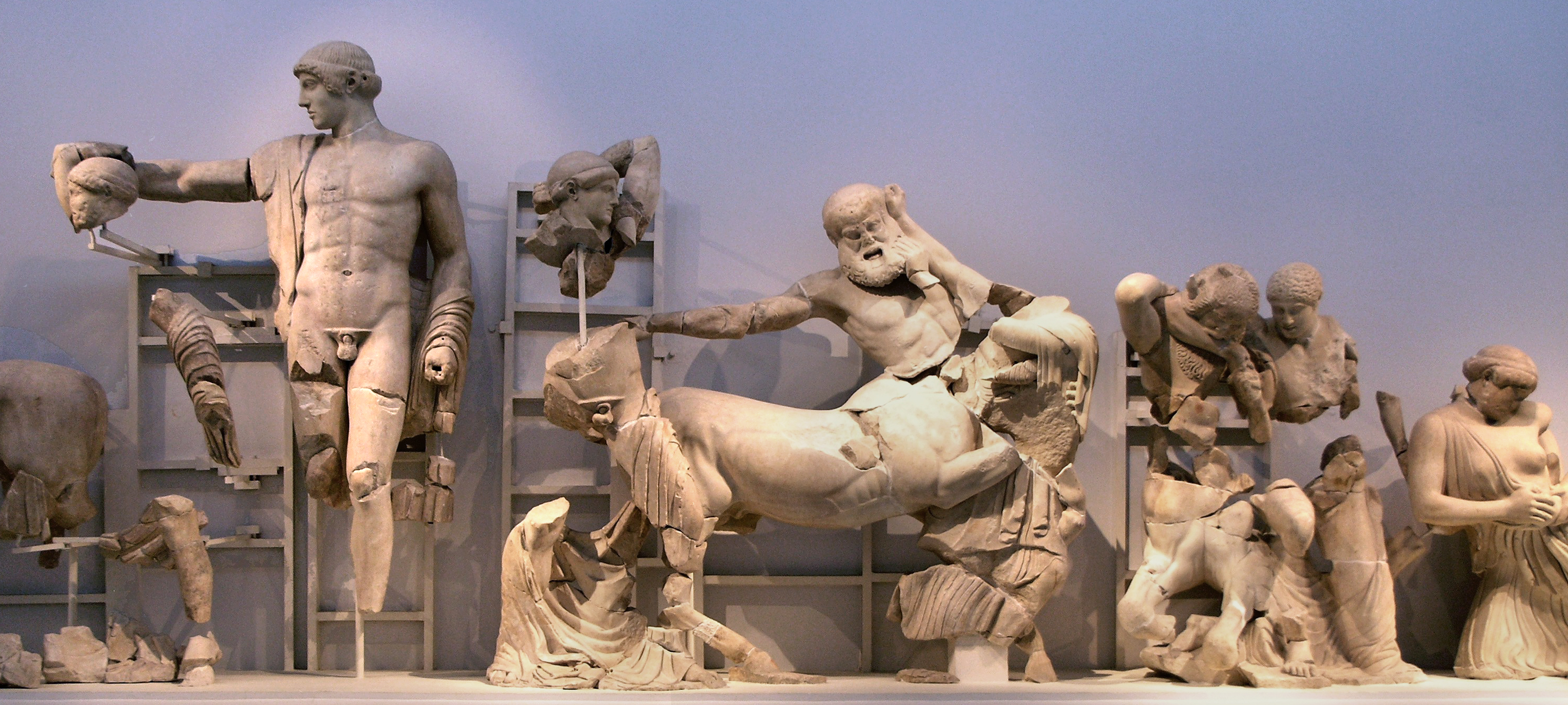|
Paeonius Of Mende
Paeonius ( grc-gre, Παιώνιος ''Paiṓnios'') of Mende, Chalkidiki was a Greek sculptor of the late 5th century BC. He most likely received his early training in Northern Greece and is thought to have later adapted Athenian stylistic elements into his own work, based upon his probable interaction with the Olympia workshop of Phidias. In any case, he was “attic-trained.” Paeonius won the commission to decorate the acroteria of the Temple of Zeus at Olympia, as described in the pedestal inscription on his Nike statue. An ancient account also references Paeonius' work at Olympia. Pausanias attributes the front (east) pedimental sculptures of the Temple of Olympian Zeus to Paeonius. The Nike Temple parapet at Athens is also often attributed to Paeonius, on the basis of similarities between the styles of drapery on both monuments. Despite this assertion, scholars continue to debate the reliability of these attributions based upon the various interpretations of the sc ... [...More Info...] [...Related Items...] OR: [Wikipedia] [Google] [Baidu] |
Mende (Greece)
Mende ( grc, Μένδη), also Mendae or Mendai (Μένδαι), or Menda (Μένδα), or Mendis, was an ancient Greek city located on the western coast of the Pallene peninsula in Chalkidiki, facing the coast of Pieria across the narrow Thermaic Gulf and near the modern town of Kalandra. History Mende was probably built during the 9th century BC by Eretrian colonists. The city owes its name to the ''minthe'' plant, a species of mint that still sprouts in the area. Mende's abundant lumber resources and possession of silver, gold and lead mines led to its rapid development. From the 6th century BC, it was one of the cities that controlled trade routes along the coast of Thrace; there were even confirmed dealings with the Greek colonies in Italy, especially concerning the export of the famous local wine ''Mendaeos oinos''. During the 5th century BC, Mende became one of the most important allies of Athens and joined the Delian League, paying a tax that varied from six up to ... [...More Info...] [...Related Items...] OR: [Wikipedia] [Google] [Baidu] |
Nike (goddess)
In Greek mythology, Nike (; grc, Νίκη, lit=victory, ancient: , modern: ) was a goddess who personified victory in any field including art, music, war, and athletics. She is often portrayed in Greek art as Winged Victory in the motion of flight; however, she can also appear without wings as "Wingless Victory" when she is being portrayed as an attribute of another deity such as Athena.Suidas. ''The Suda on Line: Byzantine Lexicography''. Translated by Whitehead, David, et al. (2014). Accessed 9 December 2022. https://www.cs.uky.edu/~raphael/sol/sol-html/ In Greek literature Nike is described as both an attribute and attendant to the gods Zeus and Athena. Nike gained this honored role beside Zeus during the Titanomachy where she was one of the first gods to offer her allegiance to Zeus. At Athens, Nike became a servant to Athena as well as an attribute of her due to the prominent status Athena held in her patron city. The fusion of the two goddesses at Athens has contributed to ... [...More Info...] [...Related Items...] OR: [Wikipedia] [Google] [Baidu] |
Ancient Olympia
Olympia ( el, label=Modern Greek, Ολυμπία ; grc, Ὀλυμπία ), officially Archaia Olympia ( el, label=Modern Greek, Αρχαία Ολυμπία; grc, Ἀρχαία Ὀλυμπία, links=no; "Ancient Olympia"), is a small town in Elis on the Peloponnese peninsula in Greece, famous for the nearby archaeological site of the same name. This site was a major Panhellenic religious sanctuary of ancient Greece, where the ancient Olympic Games were held every four years throughout Classical antiquity, from the 8th century BC to the 4th century AD. They were restored on a global basis in 1894 in honor of the ideal of peaceful international contention for excellence. The sacred precinct, named the Altis, was primarily dedicated to Zeus, although other gods were worshipped there. The games conducted in his name drew visitors from all over the Greek world as one of a group of such "Panhellenic" centres, which helped to build the identity of the ancient Greeks as a nation. D ... [...More Info...] [...Related Items...] OR: [Wikipedia] [Google] [Baidu] |
Ancient Greek Sculptors
Ancient history is a time period from the beginning of writing and recorded human history to as far as late antiquity. The span of recorded history is roughly 5,000 years, beginning with the Sumerian cuneiform script. Ancient history covers all continents inhabited by humans in the period 3000 BCAD 500. The three-age system periodizes ancient history into the Stone Age, the Bronze Age, and the Iron Age, with recorded history generally considered to begin with the Bronze Age. The start and end of the three ages varies between world regions. In many regions the Bronze Age is generally considered to begin a few centuries prior to 3000 BC, while the end of the Iron Age varies from the early first millennium BC in some regions to the late first millennium AD in others. During the time period of ancient history, the world population was already exponentially increasing due to the Neolithic Revolution, which was in full progress. While in 10,000 BC, the world population stood at ... [...More Info...] [...Related Items...] OR: [Wikipedia] [Google] [Baidu] |
5th-century BC Greek Sculptors
The 5th century is the time period from 401 ( CDI) through 500 ( D) ''Anno Domini'' (AD) or Common Era (CE) in the Julian calendar. The 5th century is noted for being a period of migration and political instability throughout Eurasia. It saw the collapse of the Western Roman Empire, which came to an end in 476 AD. This empire had been ruled by a succession of weak emperors, with the real political might being increasingly concentrated among military leaders. Internal instability allowed a Visigoth army to reach and ransack Rome in 410. Some recovery took place during the following decades, but the Western Empire received another serious blow when a second foreign group, the Vandals, occupied Carthage, capital of an extremely important province in Africa. Attempts to retake the province were interrupted by the invasion of the Huns under Attila. After Attila's defeat, both Eastern and Western empires joined forces for a final assault on Vandal North Africa, but this campaign was ... [...More Info...] [...Related Items...] OR: [Wikipedia] [Google] [Baidu] |
Messenian Wars
Messenian Wars refers to the wars between Messenia and Sparta in the 8th and 7th centuries BC as well as the 4th century BC. *First Messenian War *Second Messenian War *Third Messenian War The helots (; el, εἵλωτες, ''heílotes'') were a subjugated population that constituted a majority of the population of Laconia and Messenia – the territories ruled by Sparta. There has been controversy since antiquity as to their ex ... {{Authority control ... [...More Info...] [...Related Items...] OR: [Wikipedia] [Google] [Baidu] |
Sparta
Sparta ( Doric Greek: Σπάρτα, ''Spártā''; Attic Greek: Σπάρτη, ''Spártē'') was a prominent city-state in Laconia, in ancient Greece. In antiquity, the city-state was known as Lacedaemon (, ), while the name Sparta referred to its main settlement on the banks of the Eurotas River in Laconia, in south-eastern Peloponnese. Around 650 BC, it rose to become the dominant military land-power in ancient Greece. Given its military pre-eminence, Sparta was recognized as the leading force of the unified Greek military during the Greco-Persian Wars, in rivalry with the rising naval power of Athens. Sparta was the principal enemy of Athens during the Peloponnesian War (431–404 BC), from which it emerged victorious after the Battle of Aegospotami. The decisive Battle of Leuctra in 371 BC ended the Spartan hegemony, although the city-state maintained its political independence until its forced integration into the Achaean League in 192 BC. The city nevertheless ... [...More Info...] [...Related Items...] OR: [Wikipedia] [Google] [Baidu] |
Battle Of Sphacteria
The Battle of Sphacteria was a land battle of the Peloponnesian War, fought in 425 BC between Athens and Sparta. Following the Battle of Pylos and subsequent peace negotiations, which failed, a number of Spartans were stranded on the island of Sphacteria. An Athenian force under Cleon and Demosthenes attacked and forced them to surrender. Overview In the wake of the failed peace negotiations, Demosthenes initially attempted to starve out the Spartans on Sphacteria, but was unable to blockade the island tightly enough. In Athens there was concern that the approach of winter would necessitate abandoning the blockade, unless the impasse was swiftly broken. The politician Cleon took out reinforcements from Athens and joined forces with Demosthenes, and the Athenians launched an assault on Sphacteria. Landing in great force on a weakly defended point, the Athenians swamped the beachfront defenses and moved inland, harassing the Spartans by using bows and spears, whenever they attemp ... [...More Info...] [...Related Items...] OR: [Wikipedia] [Google] [Baidu] |
Olympia, Greece
Olympia ( el, label=Modern Greek, Ολυμπία ; grc, Ὀλυμπία ), officially Archaia Olympia ( el, label=Modern Greek, Αρχαία Ολυμπία; grc, Ἀρχαία Ὀλυμπία, links=no; "Ancient Olympia"), is a small town in Elis on the Peloponnese peninsula in Greece, famous for the nearby archaeological site of the same name. This site was a major Panhellenic religious sanctuary of ancient Greece, where the ancient Olympic Games were held every four years throughout Classical antiquity, from the 8th century BC to the 4th century AD. They were restored on a global basis in 1894 in honor of the ideal of peaceful international contention for excellence. The sacred precinct, named the Altis, was primarily dedicated to Zeus, although other gods were worshipped there. The games conducted in his name drew visitors from all over the Greek world as one of a group of such "Panhellenic" centres, which helped to build the identity of the ancient Greeks as a nation. D ... [...More Info...] [...Related Items...] OR: [Wikipedia] [Google] [Baidu] |
Chalkidiki
Chalkidiki (; el, Χαλκιδική , also spelled Halkidiki, is a peninsula and regional unit of Greece, part of the region of Central Macedonia, in the geographic region of Macedonia in Northern Greece. The autonomous Mount Athos region constitutes the easternmost part of the peninsula, but not of the regional unit. The capital of Chalkidiki is the town of Polygyros, located in the centre of the peninsula, while the largest town is Nea Moudania. Chalkidiki is a popular summer tourist destination. Name ''Chalkidiki'' also spelled ''Halkidiki'' () or ''Chalcidice'' () was the name given to this peninsula after Chalkida. In ancient times, the area was a colony () of the ancient Ionian Greek city-state of Chalcis. Geography The Cholomontas mountains lie in the north-central part of Chalkidiki. Chalkidiki consists of a large peninsula in the northwestern Aegean Sea, resembling a hand with three 'fingers' (though in Greek these peninsulas are often referred to as 'legs'). ... [...More Info...] [...Related Items...] OR: [Wikipedia] [Google] [Baidu] |
Archaeological Museum Of Olympia
The Archaeological Museum of Olympia (Greek: Αρχαιολογικό Μουσείο Ολυμπίας) is one of the principal museums of Greece, located in Olympia. It is overseen by the Ministry of Culture and Sports, and, as of 2009, is directed by Georgia Xatzi. When the original building was completed and opened in 1882, it was the first museum in Greece outside of Athens. The museum houses discoveries from the surrounding area, including the site of the Ancient Olympic Games. The collection includes objects produced and used in the area from prehistory to its time under Roman rule. The principal pieces in the museum are ''Hermes and the Infant Dionysus'' (attributed to Praxiteles), some objects from the Temple of Zeus, the Nike of Paionios, as well as an oenochoe that belonged to Phidias. The extent of its bronze collection makes it one of the most important in the world. Today, the museum is housed in two buildings: the principal building with twelve rooms for exhibition ... [...More Info...] [...Related Items...] OR: [Wikipedia] [Google] [Baidu] |








